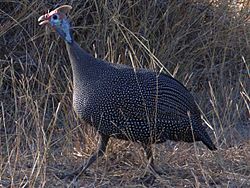Guineafowl facts for kids
Quick facts for kids Guineafowl |
|
|---|---|
 |
|
| Helmeted Guineafowl, Numida meleagris | |
| Scientific classification | |
| Kingdom: | |
| Phylum: | |
| Class: | |
| Order: | |
| Family: |
Numididae
de Sélys Longchamps, 1842
|
| Genera | |
|
|
Guineafowl are a family of birds often called "pet speckled hens." They belong to the same group as pheasants, turkeys, and other game birds.
These birds originally come from the dry areas of Africa. Today, people raise them for their meat, especially in India.
Contents
What Guineafowl Look Like
Guineafowl are ground-nesting birds that eat insects and seeds. They look a bit like partridges. A key feature is their featherless heads. However, two types, the Guttera species, have a cool black crest. The vulturine guineafowl has a soft brown patch on its neck.
Most guineafowl have dark grey or black feathers with many white spots. But some, like the Agelastes species, do not have these spots. Guineafowl are large birds. They can be from 40 to 71 centimeters (16 to 28 inches) long. They usually weigh between 700 and 1600 grams (1.5 to 3.5 pounds).
How Guineafowl Behave and Live
Most guineafowl species are monogamous, meaning they mate for life. Sometimes, they might have a new partner in a different season. However, some helmeted and Kenya crested guineafowl have been seen having multiple partners when kept in zoos.
All guineafowl are social birds. They usually live in small groups or large flocks. Even though they are monogamous, some types, like the Guttera, Agelastes, and Acryllium species, tend to have social polyandry. This means one female mates with several males. Other birds like the roul roul and Congo peafowl share this trait.
What Do Guineafowl Eat?
Guineafowl often follow large animals and groups of monkeys. They search for food in animal waste and eat things that fall from trees. They are very helpful in controlling pests. Guineafowl eat ticks, flies, locusts, scorpions, and other small creatures. They also pick maggots from dead animals and manure.
Guineafowl in Flight
Wild guineafowl are strong fliers. Their chest muscles are dark, which helps them fly for long distances if they need to escape danger. Grass and bush fires are a big threat to these birds. Flying away is their best way to stay safe.
Some guineafowl, like the vulturine type, can go a long time without drinking water. They get all the moisture they need from their food. Young guineafowl are very sensitive to cold weather.
Where Guineafowl Live
Guineafowl species live all over sub-Saharan Africa. Some types are found across almost the entire region. Others, like the plumed guineafowl, live only in west-central Africa. The vulturine guineafowl is found in north-east Africa.
They prefer semi-open areas like savannas or semideserts. However, some, like the black guineafowl, mostly live in forests. Some guineafowl even perch high up in treetops.
The helmeted guineafowl has been brought to other parts of the world. You can find them in East Africa, the West Indies, the United States, Britain, and India. In these places, people raise them for food or as pets.
Guineafowl as Food
Guineafowl meat is different from chicken. It is drier and has less fat. It also has a stronger, more "gamey" taste. Guineafowl meat has slightly more protein than chicken or turkey. It also has fewer calories per gram than chicken.
The eggs from guineafowl are also very rich. They are much richer than chicken eggs.
Images for kids
See also
 In Spanish: Pintadas para niños
In Spanish: Pintadas para niños





